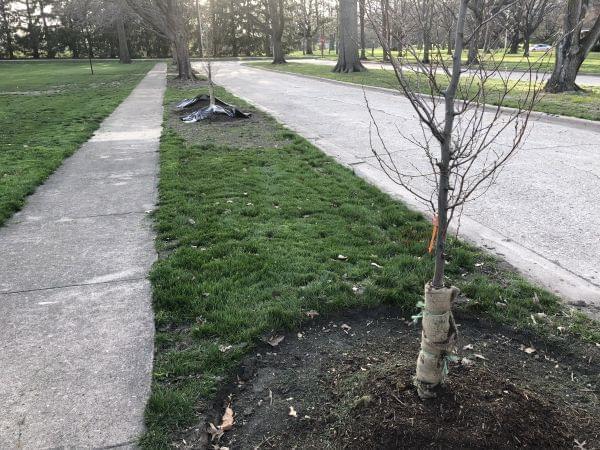Study: More Green Space At Schools Not Linked To Better Student Test Scores

Freshly planted trees in Urbana, Ill. Daniel Baker/Illinois Public Media
A new study from the University of Illinois found no link between green space on school campuses and academic outcomes. The study examined greenery and third grade test scores on reading and math exams at 400 Chicago Public Schools. The study was a replication of a 2014 analysis of Massachusetts schools.
That study concluded that more green space correlated with higher scores on third grade standardized tests.
Matthew Browning, a professor of recreation, sport and tourism at the U of I and one of the co-authors of the study, said “we’re not finding this relationship at all” in the Chicago schools.
Browning said he’s reviewed a dozen studies that examine relationships between green space and academic achievement, and “we are finding across the board that there’s been really weak evidence for an effect between green space on schools and academic performance.”
Browning also said they concluded that the Massachusetts study was not statistically sound.
But he notes that Chicago Public Schools are vastly different than the schools involved in the Massachusetts analysis. For starters, he said, Chicago schools have much less green space in general, and more students who qualify for free and reduced lunch.
Still, he said, even adjusting for those variables, green space did not appear to impact school performance.
But that doesn’t mean more research shouldn’t be done, he said.
“There's enough evidence that we should continue looking at this relationship and seeing why we find effects in some populations and not others,” Browning said.
He also said that the lack of an effect “doesn’t actually matter because there are so many other benefits you can get from this really low-cost intervention.”
Browning pointed to research that suggests more greenery promotes better mental health, as well as other health benefits.
He contends that adding greenery to school campuses is a low cost way to benefit the student body. “And it may impact academic performance, but the research doesn’t really strongly support that yet,” Browning added.
He said the benefits may be especially profound for students from lower income backgrounds who may be struggling financially or with other obstacles.
The U of I study also found that Chicago schools that serve primarily poorer students had significantly less green space than schools with wealthier student bodies.
“If you are living in poverty and you're exposed to a lot of psychosocial stressors because you're a person of color, your parents are working multiple jobs, or maybe you have a single parent household, you're exposed to crime on a daily basis, you're eating poor nutrition and so on and so on and so forth, then green space might have a bigger effect on you, even if it's just a small increase,” Browning said.
The U of I study is entitled “Greenness and school-wide test scores are not always positively associated – A replication of ‘linking student performance in Massachusetts elementary schools with the ‘greenness’ of school surroundings using remote sensing’” and can be found online here.
Follow Lee Gaines on Twitter: @LeeVGaines
Links
- Study: Student Loan Debt Hinders Wealth Accumulation For Black, Hispanic Borrowers
- Study: Most Young Adults Lack Financial Literacy, Opportunities
- New Study Links Key Nutrients to Higher Cognition and Brain Health
- Study: For Black Women With Breast Cancer, Segregation & Other Factors Linked To Worse Outcomes
- Study: Bad Behavior In Middle School Could Impact High School Graduation Rates
- Study: Intensive Agriculture Drives Midwest Climate Changes
- New Study Supports Link Between Gut Health & Brain Development
